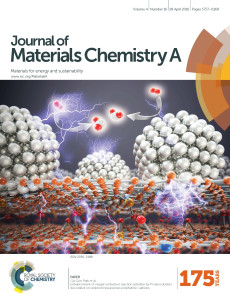Toward Cost-Effective Polymer Electrolyte Fuel Cells
DFT Calculations Run at NERSC Show Less Platinum is Possible
August 8, 2016
Contact: Kathy Kincade, kkincade@lbl.gov, 510-495-2124
As we enter the age of hybrid, electric and self-driving cars, interest remains high in finding the next generation of fuel cell technology that is low cost, long lasting and mass producible. In recent years, fuel cell research and development efforts have been focused on improving performance and reducing costs through the development of new materials and better water and heat management processes.
Toward this end, a research team running density functional theory (DFT) calculations at Berkeley Lab's NERSC center has demonstrated how one type of fuel cell—polymer electrolyte fuel cells (PEFCs)—can be made to run more efficiently and produced more cost-effectively by reducing the amount of a single key ingredient: platinum. Their findings were published April 28, 2016 in the Journal of Materials Chemistry A and featured on the issue’s inside front cover.
While the concept of the fuel cell—generating electricity by reversing the electrolysis of water—dates back to the mid 1800s, it took until 1932 to achieve the first successful fuel cell device: a hydrogen-oxygen cell that used alkaline electrolytes and nickel electrodes. By the 1950s, NASA began investing in the technology for use in its space program, and over the years fuel cells have supplied electricity to numerous space missions.
Today a variety of fuel cell technologies—distinguished by their electrolytes—are being developed and tested as an alternative to the internal combustion engine and other energy sources. In addition to PEFCs, these include:
- Solid oxide fuel cells (SOFCs), an electrochemical conversion device that uses a ceramic electrolyte or solid oxide
- Molten carbonate fuel cells (MCFCs), high temperature fuel cells that use an electrolyte composed of a molten carbonate salt mixture suspended in a porous, chemically inert ceramic matrix of beta-alumina solid electrolyte
- Phosphoric acid fuel cells (PAFCs), which use liquid phosphoric acid as the electrolyte and were the first fuel cells to be commercialized
Each has its pros and cons; for example, while SOFCs exhibit relatively higher efficiency and are relatively low cost, their high operating temperature—in the 500-1,000oC range—results in longer start-up times and mechanical and chemical compatibility issues. Conversely, PEFCs—which also have high energy conversion efficiency—operate at much lower temperatures (< 100oC), which results in much faster start-up times (within seconds).
Leading Candidate for Transportation Applications
As a result, PEFCs are considered the leading candidate for use in transportation applications and for megawatt-size power generation systems. However, figuring out how to produce these fuel cells efficiently and cost-effectively at mass scale has proven to be a challenge. The culprit lies in the cathode materials typically found in current PEFCs, which use platinum-based electrodes and a water-based, acidic polymer membrane as the electrolyte. The problem? Platinum is expensive.
“Even though PEFCs are well known as an ideal electrical power system, the utilization of platinum hinders the cost-effective commercialization of these type of fuel cells,” said Yongman Choi, lead scientist at the SABIC Technology Center in Riyadh, Saudi Arabia and a co-author on the Journal of Materials Chemistry A study. Choi's collaborators included Mi Hwang and Gu-Gon Park at Korea Institute of Energy Research.
While some non-precious metal-based catalysts have demonstrated enhanced activity, their oxygen reduction reaction (ORR) activity is still inferior to that of platinum-based catalysts, resulting in a much thicker electrode. Thus Choi and his colleagues DFT calculations to test a non-precious-metal-based cathode material containing only a small amount of platinum. Their calculations, which used approximately 300,000 core hours at NERSC—a DOE Office of Science user facility—confirmed that platinum nanoclusters on metal–nitrogen doped ordered mesoporous porphyrinic carbon significantly enhance the ORR activity.
“Although more studies, including stability examination, are imperative, it is promising to reduce the cost by lowering the platinum amount in the fuel cell electrodes,” Choi said. “The confirmation of the experimental finding on the basis of scientific models like this study using DFT-based simulations can guide the design of new catalytic materials that have high activity and stability.”
About Computing Sciences at Berkeley Lab
High performance computing plays a critical role in scientific discovery. Researchers increasingly rely on advances in computer science, mathematics, computational science, data science, and large-scale computing and networking to increase our understanding of ourselves, our planet, and our universe. Berkeley Lab’s Computing Sciences Area researches, develops, and deploys new foundations, tools, and technologies to meet these needs and to advance research across a broad range of scientific disciplines.







 Instagram
Instagram YouTube
YouTube